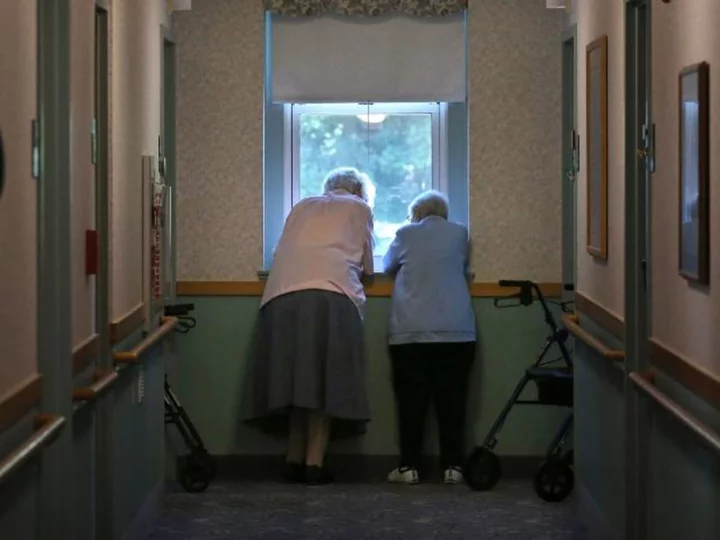About one in six Americans are now age 65 or older and, as the average population ages, a majority are reaching the age of retirement in a precarious financial position, as costs of personal care continue to rise.
"Living a long life is something that many of us want and could get," said Jesse Slome, executive director of the American Association for Long-Term Care Insurance, an insurance education group. "But when we live a long life, the chances of us needing long-term care increase exponentially. But when you need that type of care, there are limited options."
Long-term care for older adults includes help with standing, eating and showering, as well as medical support like physical and speech therapy. The Department of Health and Human Services projects more than 56% of those turning 65 will need some sort of long-term service. Medicare only covers shorter-term services and Medicaid covers help for qualifying individuals. Those not eligible for government services often choose to rely on spouses or children who pay for services out of pocket, according to experts.
Insurance is an option for some
Long-term care insurance, a very niche and complex market, has traditionally been an option for those able to buy policies, but it is far from the norm.
Only 7.5 million people had an active plan in place as of 2020, with uptake generally decreasing year over year, according to the association's research. The Census Bureau estimates there are almost 58 million adults aged 65 or older in the US, and the number is increasing. The HHS expects more than 1 in 5 Americans will be 65 or older by 2040.
"The population of seniors who buy long-term care insurance constitutes a segment of the population who are healthier and their longevity is likely different than the nation as a whole," said Slome. "They tend to be educated on what they're buying, and they have to be able to afford it.
Those services have been getting pricier, forcing some insurers to exit the market in recent years due to increased costs. A report published last week by credit rating agency AM Best found claims for long-term care insurance in 2022 exceeded $13 billion, up from around $10 billion in 2021 and a jump of 20% from pre-pandemic levels. Analysts attribute the uptick to inflation bumping up medical supply costs, as well as staffing shortages at care facilities such as nursing homes.
"There is a need for education in the United States about the necessity of preparing for long-term care," Jason Hopper, an associate director at AM Best, told CNN in a statement. "Programs such as Medicare offer limited benefits and this needs to part of retirement considerations for citizens as they think about financial planning for retirement and beyond. It is in these stages when the acute need for a long-term care program will be felt."
According to an analysis from the association, the typical annual premium for a 65-year-old costs between $1,700 and $7,225. By comparison, the median income for older adults in 2019 was barely over $27,000.
Ramsey Alwin, president and CEO of the National Council on Aging, a non-profit advocacy organization, said the surging cost of claims are not surprising and could raise premiums in the long term. "Our concern is that ... it will get even more expensive for those who have had the modest resources to access long-term care insurance to be able to afford it," she noted.
Premium costs depend on various factors, such as gender, weight, the medications a person takes, and their mobility, according to Slome. "There are very stringent health requirements and they get more stringent as you get older," he said, adding eligibility for insurance typically nose-dives when people reach their 70s.
Aging well is an equity issue
People living in low-income communities are in danger of a slew of poor health outcomes such as chronic illness and nutritional deficiencies due to higher stress levels, unstable living conditions, and a lack of access to healthy foods and health care as they age, which means lower-income earners who may not qualify for government services like Medicaid will still likely face higher premium costs if they try to buy a long-term care insurance policy.
In 2022, the HHS estimated "on average, an American turning 65 ... will incur $120,900 in future (long-term services and supports) costs, measured in today's dollars." Nearly 40% of the cost will need to be paid out-of-pocket by their families, the department added.
Low-income older adults are also more likely to need long-term support, with the HHS projecting 63% of those making the lowest incomes in the country will need at least some care. Almost one-third will need more than five years of care, the department found.
According to a report released by the council earlier this year, 80% of households with older adults are in such a financially precarious position they "would be unable to absorb a financial shock such as long-term services and supports."
"The do-it-yourself retirement that we have in place right now, where the cost of aging well falls all on the individual shoulders, is not working," said Alwin. "Aging well should be a right, not a privilege based on factors out of your control like gender, race, ethnicity, income, and ZIP code."
Some states have begun implementing their own long-term care services for residents. In 2019, Washington state signed into law a mandatory tax on all workers who go into a public care fund. Washington insured more than 155,000 people in 2021, accounting for more than half of the total lives insured during the year, according to the AM Best report.
"We need to take a fresh look at the role that government can play, and we need a multi-sectoral strategy that is layered and leveraged with the private sector," said Alwin, noting the Washington fund is "very promising."
The Washington tax went into effect this year. The fund will become active in 2026, at which point any resident who qualifies for care will be able to access up to $36,500 in lifetime benefits, adjusted for inflation. Pennsylvania, California and New York are among a dozen or so states that have considered similar programs.









